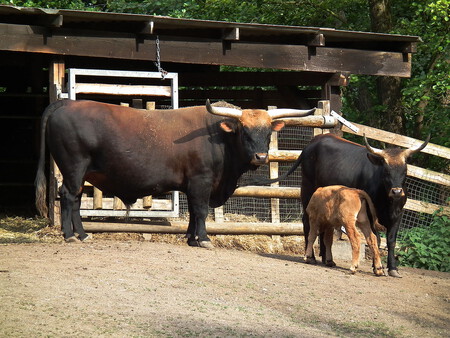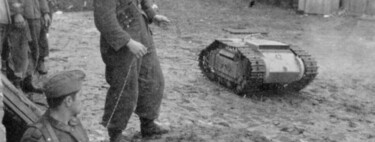In 2009 Dereck Grow, a farmer from Devon, in the south-west of the United Kingdom, had an idea that was as strange as it was promising in appearance: he imported from Belgium a dozen giant “Nazi” cows and bulls, also known as Heck cattle. He did it – he explained at that time very proudly to media such as the BBC – because he was convinced that they would help to conserve British prairies. The attempt went frog. Six years later, Grow was back in the news because he had been forced to slaughter half of his herd due to the aggressiveness of the animals.
The experience of Grow and his cows from the Third Reich sounds like a Saturday afternoon movie script; but the truth is that it is real and it is related to one of the coolest projects of the already delusional Nazi Amenia: the attempt to recreate in the Białowieża Forest, in Poland, an ecosystem based on the philosophy of Lebensraum, the idyllic German living space; and in the medieval epic poem Nibelungenlied. To achieve this, they did not even hesitate to try to revive already extinct species and give shape to a kind of —if we continue with the cinephile metaphors— Nazi Jurassic Park.
But did that Jurassic Park of the III Reich come into existence?
And what are the “Nazi” giant cows?
Let’s go by parts.
Objective: resurrect the aurochs
In the 1920s, before Hitler came to power, Heinz and Lutz Heck, two German zoologists, had a dream: they wanted to “resurrect” the aurochs (Bos primigenius primigenius), a kind of wild bull of enormous size —it weighed around a ton and a half and its withers were as tall as a man— that had been extinct since the 17th century due to hunting and cattle competition. To a large extent, Lutz’s interest was rooted in the fascination with the mythical, epic German past, the same one that is related with a good dressing of fantasy in the verses of the hero Siegfried.
The problem is that when the Hecks got down to work, the discovery of the DNA double helix was still decades away. How to get it then? Well, reversing more or less the process of domestication. The Hecks were convinced that modern cattle are descended from the aurochs, so they thought they just had to find the “footprints” of their lost lineage and retrieve them. To that end, they studied cave paintings, measured skulls, and traveled to hunt for species that displayed the characteristics they associated with aurochs.
For their investigations, the Hecks traveled the world and searched for species in which they believed they identified some of the traits of the aurochs. Each of the brothers followed their own line of work. Lutz looked, for example, at the fighting bulls of Spain and Heinz used, among others, Corsican, Hungarian and Scottish cattle. By the mid-1930s they both believed they had revived the old European wild bulls. From 1932 dates the Glachl, the first copy of Lutz. As it grew, however, the animal disappointed zoologists. The objective was to reproduce the bearing, the antlers and an aggressive attitude that they associated with the aurochs and their ability to live in freedom.

Helk cattle.
The 1930s would however be important for another reason. In January 1933 Hitler became chancellor and Germany embarked on a drift that —detailed Smithsonian Magazine— separated the paths of both brothers in a way and marked the future of Lutz. The older Heck joined the Nazi Party and managed to befriend Hermann Göring, a government heavyweight, commander-in-chief of the Luftwaffe, and one of Hitler’s closest associates. big fan of hunting and with a similar passion for Lebensraum and the mythical Germanic past, Göring backed up his plans.
In 1938 the Nazi leader appointed Lutz Heck in charge of the Nature Protection department and supported his breeding experiments with bulls, bison and tarpans, wild horses that had become extinct at the beginning of the 20th century. To demonstrate that they could survive in freedom, without the support of men, the creatures were released in the hunting ground of Göring himself, who entertained the idea of emulating the epic hunts of the hero Siegfried. However, a fundamental piece was missing to reach that mythical place that the leader of the Luftwaffe dreamed of: a setting at the height of the aurochs, a forest worthy of epic adventures and the pages of the Nibelungenlied.
The chosen one was the impressive virgin forest of Białowieża, a territory today divided between Poland and Belarus and home to the almost extinct European bison. Göring’s plans seemed to go back even before the war. A photo from 1937, two years before German troops entered Poland, shows the Nazi leader with Heck in Berlin, in front of a relief model of Białowieża filled with figurines of wild animals. On the map, as an ornament, rests an elongated crow very similar to those of the aurochs itself.
Around 1942 the huge wild bulls of Heck were released in Białowieża, among the bears, wolves, capercaillies and the almost extinct European bison that already inhabited the reserve, thus giving shape to a kind of Nazi Jurassic Park very much in line with the philosophy of the leaders of the Third Reich. The story of the Polish forest is however much less funny than the fiction of Steven Spielberg; and unfortunately just as bloody. The creation of that German-style ecosystem served the Nazis as one more justification for their campaign of hatred, destruction and systematic murder.

Illustration of an aurochs in a publication from the 16th century.
Under the banner of Germanization and keeping a tragic parallel with the selection of races undertaken by the Hecks themselves, the Nazis persecuted all those inhabitants of the area who did not comply with the Aryan stereotype. He charged against the Jews of Białowieża and the forest served as a battlefield in the fight against the Polish resistance and Soviet partisans. As the war progressed and the allied troops gained ground, the “regenerated” creatures that Heck had pampered for years also ended up being victims of the war.
The frustrated project of Nazi “Jurassic Park” did not prevent that even today, more than half a century later, there are still copies of those known as cattle or Heck horses. Ironies of history, thanks to DNA today we know that their calves were very far genetically from the aurochs, so much so that they were far from some of the species they used as a starting point.
Yet it is very likely that Lutz regarded with approval the fierce character of the bulls that thwarted the plans of the farmer from England. A proof of the wild and indomitable character that he supposed to the Uros; exactly like the T-Rex from Steven Spielberg movies.
The desire to revive the wild aurochs, by the way, is still alive and kicking.
Images | Frank Vassen (Flickr), 4028mdk09 (Wikipedia) and Wikimedia
George is Digismak’s reported cum editor with 13 years of experience in Journalism

